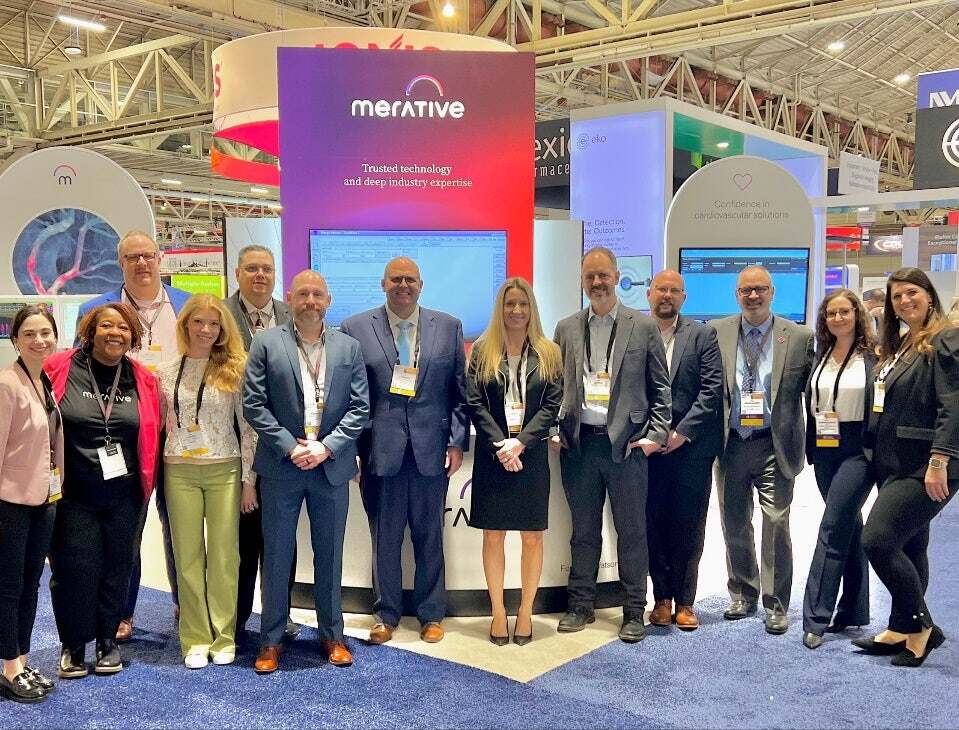ACC 2023: 3 takeaways on the future of cardiology imaging

Due to other work responsibilities, I unfortunately missed ACC the past five years. Before that, I was on a 20+ year streak of attending the “greatest show on earth.” Needless to say, it was great to be back on the show floor a few weeks ago. Not only was it nice to see familiar faces but being able to explore new technologies and innovations reminded me of why I enjoy this conference so much.
Engaging with current customers as well as new prospects is always a highlight. It certainly helps when we can be speaking with cardiologists, technicians, and IT teams about Merge Cardio and Merge Hemo – products recently awarded Best in KLAS for 2023. It was nice to see these products back in their rightful place – on top! ACC 2023 doubled down on the familiar – with an emphasis on optimizing cardiology workflows and the CVIS solutions that can address these needs best – as well as spotlighting the new kid on the block: AI.
Here are a few of my key takeaways from this year’s ACC on the future of cardiology imaging.
Seamless cardiology solutions
Foundational elements still ring true: The mark of an effective solution is one that enables clinicians, IT, and administrators to do their jobs more efficiently and without getting in their way. These solutions need to adapt to the complex, dynamic cardiology workflow.
Cardiologists, clinical staff, and patients are always on the move, so they need tools that feel like an extension of their knowledge, not something that distracts them from the task at hand. This was reinforced with nearly every engagement we had at ACC, and on display with our Best in KLAS Merge Cardio and Merge Hemo systems. It’s so rewarding to hear from customers how these Merge solutions positively impact their day-to-day lives, and most importantly, how they change the lives of their cardiology patients.
What cardiologists are looking for in CVIS
Cardiology departments need solutions that can support the management of complex cardiovascular workflows, providing holistic diagnostic reading and reporting across the entire cardiology service line. But what does that entail? And how can we leverage technology to drive real value for cardiologists?
Cardiologists have been clear on what they’re looking for in a cardiology system:
- Consolidated imaging data
- Comprehensive reporting
- Interoperability
- Centralized hemodynamics databases
- Departmental visibility
In support of these requirements, Merge Cardio addresses all major cardiology subspecialities, utilizes advanced visualization tool sets, integrates quantitative clinical data, and provides intuitive clinical reporting to drive the final diagnostic report.
In support of cardiac cath, Merge Hemo provides a unique drag and drop touchscreen data collection methodology, integrating with leading EHR vendors to drive effective pre-population of the cardiac cath diagnostic clinical report. The bottom line: If technology isn’t maximizing cardiologists’ and IT’s workflows, they are not meeting the moment. Fortunately, Merge Cardio and Merge Hemo hit the mark.
Cardiology is eager for AI
Cardiology, like all other areas in our lives, is generating more data than we can possibly process. This is where the emergence of AI will play a critical role. It can augment the cardiologist by automating the more menial tasks and free them up for the complex problem solving that is at the heart of their job.
While there is strong interest in AI, the cardiology market, like many others, is still looking for both assurances and proof points that it will deliver. AI clearly played a major role at ACC 2023. In fact, it was hard to venture very far within the exhibit hall without seeing evidence of it. It’s clear that the initial fear of AI replacing clinical personnel including cardiologists has subsided, and this has been replaced by the realization that those that embrace the technology will thrive. AI is here to stay and its anticipated growth in healthcare is expected to be sevenfold over the coming years, from its current $14.6B market to $102.7B in 2028.
In response, we are cultivating an ecosystem of AI partners who have developed cutting-edge solutions. One such partner is DiA Imaging Analysis. Their LVivo Seamless product delivers an AI-based, zero-click solution, which delivers automated Ejection Fraction, Global Longitudinal Strain, and RV analysis.
Beyond cardiology, we’re also partnering with AI vendors like Aidoc. Their AI-based decision support software analyzes medical imaging to flag acute abnormalities throughout the body, enabling care teams to prioritize life-threatening cases and expedite patient care.
Delivery of these AI solutions within the clinical workflow is key. Clinicians will not have a tolerance for disparate AI applications delivering results in pop-up boxes that can disrupt their fine-tuned workflows. In response, Merge has developed AI Orchestrator, which sends specific clinical imaging studies to the appropriate AI algorithms and delivers the results seamlessly within the clinical workflow.
It was great to get back to ACC. It was an opportunity to catch up with acquaintances, connect with customers, discover new technologies, and see firsthand what’s driving the cardiovascular market. Considering the speed at which technologies are evolving, I’m looking forward to see what ACC 2024 has to offer!
Related Articles

Merge Cardio and Merge Hemo rank Best in KLAS 2024 for cardiology and hemodynamics
The top ranked Merge solutions will be showcased at ACC.24 in April
By Ashish Sant | 2 min. read

How Duly Health and Care streamlined cardiology reporting with a Best in KLAS CVIS solution
Dr. Sujith Kalathiveetil, cardiologist and Director of Advanced Imaging,...
By Terry Ronan | 2 min. read

Merge August 2023 newsletter: Join our client success events
Hello Merge Customers, I want to take a moment to express my sincere gratitude for...
By Toni Wells | 5 min. read
Ready for a consultation?
Our team is ready to answer your questions. Let's make smarter health ecosystems, together.
